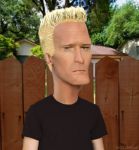Trippy Blacklight Posters From the Psychedelic Heyday

Tags: USA
Trippy Blacklight Posters From the Psychedelic Heyday published by Evanvinh
Writer Rating: 5.0000
Posted on 2016-04-18
Writer Description: Evanvinh
This writer has written 733 articles.
Whoa man. Is this poster glowing? Wait. Is that a centaur?
By Eric Grundhauser
For a magical time in the 1960s and '70s, your wood-paneled basement hideaway wasn’t worth its weight in cheap weed and questionable acid without a collection of psychedelic blacklight posters. Combining Art Nouveau, Surrealism, Pop Art, and countless other artistic styles with the relatively new (commercially anyway) phenomenon of fluorescence, these glow-in-the-dark posters became an icon of the Summer of Love and its youth culture. Here’s where they came from and how they worked.

Photo: Jeff Owenby/Used with Permission
The blacklight poster trend has its roots in the 1950s with the introduction of fluorescent paint to the mass market. Invented by brothers Joseph and Bob Switzer in the 1930s, fluorescent paint combined naturally fluorescing minerals and compounds with shellac to create pigments that would take on an eye-searing glow under ultraviolet black lights. They founded the Day-Glo Color Corporation in 1946, giving fluorescent effects their popular nickname, and bringing the effect to the general public.

(Photo: Jeff Owenby/Used with Permission)
“[The first hit fluorescent product was] the Hula-Hoop in 1958 made with 'Day-Glo' fluorescent pigments,” says Nick Padalino, owner and operator of Amsterdam’s Electric Ladyland, the first museum devoted to fluorescent art. A year later, Tide released a laundry soap in a plastic bottle made with Day-Glo fluorescent red pigment.

Man and Woman I (Photo: Jeff Owenby/Used with Permission)
While it wasn’t until the early 20th century that fluorescence began to be used as a common decoration, the effect is a naturally occurring trick of the light. “Fluorescence works through electron displacement—all fluorescence, from synthetic blacklight posters to natural fluorescent minerals around the world,” says Padalino. Fluorescent materials (phosphors) impurities called “activators” that react to normally invisible ultraviolet energy. The ultraviolet energy causes the electrons of the atoms in these activators to move out of balance, expending a small amount of energy that is then released as visible light.

(Photo: Jeff Owenby/Used with Permission)
In the case of something like a blacklight poster, this ends up appearing as mind-blowing colors. Unlike standard white light, which is only visible as it is reflected, the light—and therefore colors—coming from blacklight posters (or any fluorescent substance for that matter) is emitted from the atoms that have absorbed the ultraviolet radiation. Far out, man.

(Photo: Jeff Owenby/Used with Permission)
By the mid-1960s, fluorescent paints, and products that incorporated them, were not only easy to come by, but found a massive audience in the psychedelic music scene growing out of the counterculture movement, especially in San Francisco. Surreal, psychedelic design began to take over the youth scene thanks to glowing concert posters for bands like the Grateful Dead and The Jimi Hendrix Experience, comic books by the likes of Robert Crumb and Kim Deitch, and underground newspapers like the San Francisco Oracle.
This florescent trend soon incorporated art, quickly making the UV glow a popular motif symbolic of the counterculture. In an essay on psychedelic '60s posters, Sally Tomlinson describes how, in the beginning, the posters were meant “to target a small community assumed to be LSD-savvy.”

Horizon (Photo: Jeff Owenby/Used with Permission)
Popularized in the youth music scene, blacklight posters began being sold in record stores and head shops. Many of these businesses even built special blacklight rooms where the walls were covered in posters to buy, all illuminated under a UV bulb. In addition to band posters, common subjects for blacklight posters included fantasy tableaus of warriors and scantily-clad women, trippy designs, and really anything one might hope to get lost in while under the influence.
Blacklight posters remained a decorative fixture well into the 1970s, becoming almost synonymous with velvet paintings, another kitsch art form that often incorporated fluorescent paints. Eventually psychedelia began to fall out of popular fashion, and blacklight posters with it, although they never truly disappeared. While the blacklight rooms began to disappear, blacklight posters continue to be sold in head shops and mall novelty stores. There, no matter the temperature or the time of year, the Summer of Love lives on.

(Photo: Jeff Owenby/Used with Permission)
If you want to experience the joy of blacklight posters and fluorescence for yourself, join us for a tour of Amsterdam's Electric Ladyland Museum for Obscura Day on April 16.
Sources: http://www.atlasobscura.com/articles/trippy-blacklight-posters-from-the-psychedelic-heyday
You have the right to stay anonymous in your comments, share at your own discretion.


